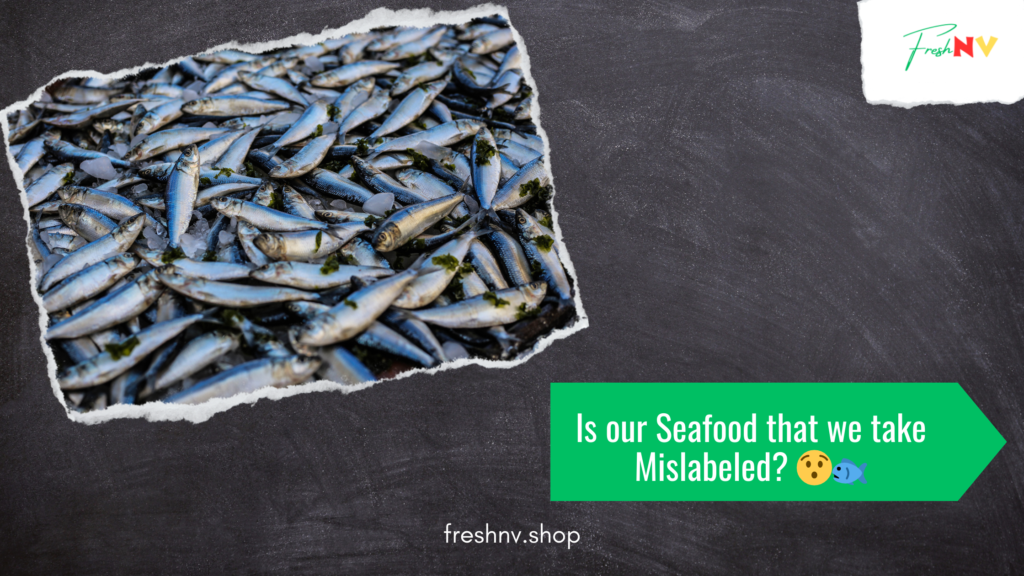The Scandal of Fake Fish: How Much of Our Seafood is Mislabeled? : FreshNv Farmer
Seafood is a staple in many diets worldwide, appreciated for its flavor and health benefits. However, a hidden problem lurks in our seafood markets and restaurants: seafood mislabeling. This scandal not only deceives consumers but also poses risks to health, finances, and marine ecosystems. This article delves into the depths of seafood mislabeling, particularly focusing on its implications in India.

The Growing Concern of Fake Fish
Seafood mislabeling has become a widespread issue. Studies have revealed that a significant portion of seafood sold in markets and served in restaurants is mislabeled, meaning it is not what it claims to be. This issue affects countries worldwide, including India, where seafood is a crucial part of the diet and economy.
How Does Seafood Mislabeling Happen?
- Supply Chain Complexity: Seafood often travels through a long and convoluted supply chain, from fishermen to processors, distributors, and retailers. Each stage increases the risk of mislabeling, either intentionally or accidentally.
- Economic Incentives: Some sellers may intentionally mislabel cheaper, lower-quality fish as more expensive varieties to increase profits.
- Lack of Regulation and Enforcement: In many regions, including India, there are insufficient regulations and enforcement mechanisms to ensure accurate labeling of seafood products.
Factors Contributing to Seafood Mislabeling
- Consumer Ignorance: Most consumers cannot easily distinguish between different types of fish, making it easier for sellers to substitute one fish for another.
- Global Trade: The international nature of the seafood industry makes tracking and verifying the authenticity of fish more difficult.
- Technological Limitations: Although DNA testing can identify fish species accurately, it is not widely used due to cost and accessibility.
Case Studies and Evidence
A study conducted in India revealed that a significant percentage of seafood samples tested were mislabeled. For example, cheaper fish like pangasius were often sold as more expensive varieties like sea bass or cod. This mislabeling not only deceives consumers but can also have serious health implications, especially for those with allergies or dietary restrictions.
Impact on Consumers and the Environment
- Health Risks: Mislabeling can lead to the consumption of fish contaminated with toxins or allergens.
- Economic Loss: Consumers pay a premium for high-quality fish but often receive lower-quality substitutes.
- Environmental Harm: Mislabeling undermines sustainable fishing efforts, as consumers may unknowingly support overfished or endangered species.
- What Can Be Done to Combat Seafood Mislabeling?1.Regulatory Improvements: Strengthening regulations and enforcement around seafood labeling can help ensure that fish are accurately labeled.
- Technological Solutions: Encouraging the use of DNA testing and other technologies to verify fish species can reduce mislabeling.
- Support Sustainable Practices: Promoting and supporting sustainable fishing practices can help maintain healthy fish populations and reduce the incentive for mislabeling.
Interesting Facts About Seafood Mislabeling in India
- High Incidence: Studies suggest that up to 30% of seafood in Indian markets may be mislabeled.
- Common Substitutions: Cheaper fish like pangasius and tilapia are often mislabeled as premium varieties like sea bass and grouper.
- Economic Impact: The seafood industry in India is worth billions of dollars, making the financial implications of mislabeling significant.
FAQs
1. What is seafood mislabeling?
Seafood mislabeling occurs when fish or other seafood is sold under a false name, often to make cheaper fish appear as more expensive varieties.
2. How common is seafood mislabeling in India?
It is estimated that up to 30% of seafood in Indian markets may be mislabeled.
3. Why is seafood mislabeling a problem?
It deceives consumers, poses health risks, causes economic losses, and undermines sustainable fishing practices.
4. How can consumers protect themselves from mislabeled seafood?
Consumers can educate themselves about different types of fish, buy from reputable sources, and support regulations that ensure accurate labeling.
5. What steps are being taken to combat seafood mislabeling?
Efforts include strengthening regulations, increasing consumer awareness, using technological solutions like DNA testing, and promoting sustainable fishing practices.
Table: Common Mislabeled Fish in India
| Original Fish | Mislabeled As | Reason for Mislabeling |
|---|---|---|
| Pangasius | Sea Bass, Cod | Cheaper, easier to farm |
| Tilapia | Grouper, Snapper | Inexpensive, abundant |
| Catfish | Sole, Halibut | Lower cost, high availability |
| Yellowtail | Tuna, Salmon | Similar appearance, higher profit |
| Pollock | Haddock, Atlantic Cod | Cheaper substitute for premium fish |
Conclusion
Seafood mislabeling is a significant issue that affects consumers, economies, and ecosystems. By raising awareness, improving regulations, utilizing technology, and supporting sustainable practices, we can tackle this problem and ensure that the seafood we consume is genuine and safe. Consumers in India and around the world must remain vigilant and informed to protect themselves and the environment from the harmful effects of seafood mislabeling.

